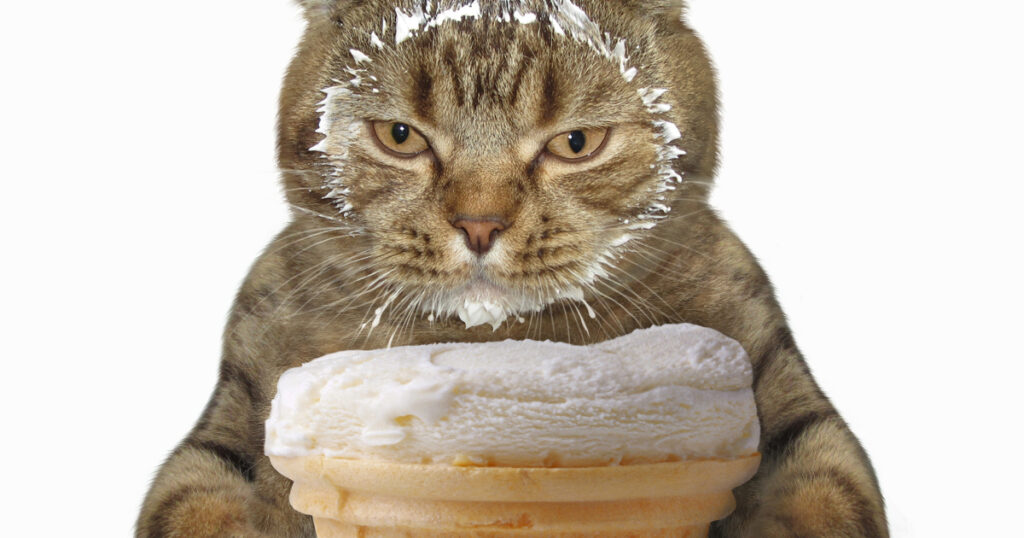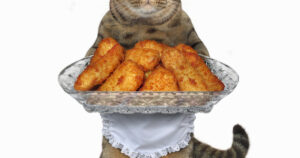As a cat owner, you likely enjoy treating your furry friend to human foods every now and then. Sharing a scoop of your favorite ice cream flavor with your cat may seem harmless. However, some ingredients found in human desserts like ice cream can be dangerous for cats. So, can cats have pistachio ice cream?

The short answer is no, cats should not eat pistachio ice cream. Pistachio ice cream contains ingredients that are unhealthy for cats, including dairy, fat, sugar, and potential toxins from pistachio nuts. Letting your cat indulge in pistachio ice cream could lead to digestive upset, pancreatitis, weight gain, and other feline health issues.
Let’s explore why pistachio ice cream is bad for cats, signs of illness to watch for, and safer treats you can offer your feline friend instead. Keep reading to learn everything you need to know about cats and pistachio ice cream.
Dangers of Pistachio Ice Cream for Cats
Pistachio ice cream may look or smell enticing to your cat, but it contains several ingredients that can wreak havoc on your cat’s health. Here are some of the biggest dangers and risks of allowing cats to eat pistachio ice cream:
High in Fat and Sugar
One of the main concerns with feeding ice cream to cats is the high fat and sugar content. Pistachio ice cream is loaded with saturated fat and sugar, neither of which cats need in their diet.
Cats are obligate carnivores, meaning they thrive on diets rich in animal protein and fat. However too much dietary fat from plant-based sources can lead to vomiting, diarrhea, and a dangerous condition called pancreatitis in cats.
Pancreatitis involves severe inflammation of the pancreas that requires intensive treatment and hospitalization. It can even be fatal in cats if not addressed quickly. Feeding fatty treats like ice cream predisposes cats to develop this serious illness.
The high sugar content in ice cream is also problematic. Cats lack taste receptors for sweet flavors and have no biological requirement for sugars. Excessive sugar can spike blood glucose to dangerous levels in some cats or lead to weight gain and dental decay. Diabetic cats in particular should never consume sugary human foods.
Contains Dairy Products
The cream or milk used to make ice cream comes from cows. Cow’s milk contains a sugar called lactose that is difficult for cats to digest.
Most adult cats are lactose intolerant, meaning their bodies lack the enzymes needed to properly digest dairy. Consuming cow’s milk products often causes digestive upset in cats within hours, resulting in:
- Diarrhea
- Vomiting
- Gas
- Bloating
- Dehydration
Some kittens can tolerate small amounts of lactose while their digestive systems are still developing. But even they are best served sticking to their mother’s milk or kitten formula. No cat of any age should consume dairy products like ice cream regularly.
Pistachio Nut Toxins

As we’ve covered, the high fat and dairy content make pistachio ice cream a poor choice for cats. However, there are additional risks associated with pistachio nuts themselves that make this flavor particularly troublesome.
Pistachios contain toxins that, while harmless to humans in small amounts, can sicken cats. Two main toxins found in pistachios are aflatoxin and persin.
Aflatoxin is produced by a fungus that commonly contaminates pistachios and other nuts. If ingested, it attacks the liver and causes vomiting, jaundice, and even liver failure in pets. Just a small amount of aflatoxin can be lethal to cats.
Persin is a fatty acid naturally found in pistachios and their shells. It’s thought to damage red blood cells, causing vomiting and diarrhea. Cats are especially sensitive to its toxic effects.
So while the ice cream itself is unhealthy, the source of the pistachio flavor poses an added risk. It’s best not to let your cat eat any products containing this nut.
Choking or Obstruction
Ice cream’s soft texture seems innocent enough. But your cat scarfing down mouthfuls could lead to a dangerous situation.
Eating too quickly or failing to properly chew ice cream raises your cat’s risk of choking. Ice cream can also freeze into a solid mass in your cat’s throat, completely blocking its airway.
If ice cream makes it to your cat’s stomach without issue, it might still cause problems later. The high-fat content slows digestion, so ice cream stays in the stomach longer. There it can form a large, solid clump that obstructs the intestines.
Gastric obstruction requires emergency surgery to remove the blockage and save your cat’s life. It’s not worth the risk just to share a tasty treat.
Signs Your Cat is Sick after Eating Pistachio Ice Cream
Hopefully reading about the potential hazards convinces you not to share pistachio ice cream with your cat. But if your sneaky feline manages to steal some anyway, watch for these signs of illness:
- Repeated vomiting or dry heaving – This may signal pancreatitis, intestinal obstruction, or other digestive issues.
- Diarrhea – Dairy and other ingredients commonly cause diarrhea in cats. Look for loose, watery, or bloody stools.
- Decreased appetite or lethargy – Your cat feeling too sick to eat or move around warrants an urgent vet visit.
- Difficulty breathing – This is a red flag your cat may be choking and needs emergency assistance.
- Drooling – Excessive drooling can indicate nausea, oral pain, or esophageal obstructions.
- Hunched posture – Stooping or arching the back suggests abdominal pain that requires prompt veterinary attention.
If your cat exhibits any concerning symptoms after eating pistachio ice cream, call your vet right away. Waiting too long can allow serious conditions like pancreatitis or intestinal blockages to progress. Rapid treatment gives your cat the best chance of recovery.
Healthier Ice Cream Alternatives for Cats

We’ve determined pistachio ice cream is not safe for cats. But if you still wish to share a cool, sweet treat with your furry best friend, some healthier options exist.
The best cat-friendly ice creams avoid dairy and instead use bases made from vegetables, fruit, or meat. They are also lower in fat and sugar compared to traditional ice cream.
Some brands specifically formulate frozen treats for pets. But you can also make homemade cat ice cream using cat-safe ingredients blended into a freeze-able puree.
Here are a few recommended cat ice cream flavors:
- Cat milk ice cream – Uses milk designed for cats instead of dairy. Great for kittens.
- Fish or meat flavored – Cat-appropriate proteins provide a tasty base.
- Vegetable blends – Carrots, sweet potatoes, and pumpkin make nourishing options.
- Fruit mixes – Try blending berries, bananas, or cantaloupe.
No matter what recipe you choose, moderation is key. Too much ice cream, even the cat-safe kind, brings risks of weight gain or digestive issues. A teaspoon or two once in a while makes a fun surprise.
Can Kittens Have Pistachio Ice Cream?
By now you understand why cats of any age should not indulge in pistachio ice cream. But what if you catch your curious kitten lapping up a spoonful? Are kittens at even greater risk?
The short answer is yes; kittens face increased danger from eating pistachio ice cream. Here’s why:
- Higher likelihood of choking – Kittens are smaller with more delicate throats, making choking more likely. Their teeth are also weaker for chewing ice cream properly.
- More sensitive digestive system – Kittens’ gastrointestinal tracts are still developing. Any harsh ingredients will hit their guts harder.
- Higher toxicity risk – Kittens’ tiny bodies cannot metabolize toxins as effectively. Small amounts of persin or aflatoxin can make kittens very sick.
- A greater tendency for hypoglycemia – Eating high-sugar foods like ice cream can cause dangerously low blood sugar in kittens.
Kittens also require very precise nutrition to support their rapid growth and development. Ice cream lacks the protein, vitamins, and minerals kittens need.
For all these reasons, pistachio ice cream poses a heightened risk for kittens. Never purposefully feed this risky human dessert to young cats.
FAQs
Are pistachios poisonous to cats?
No, pistachios are not acutely poisonous to cats. However, they do contain compounds and toxins that can cause illness if consumed, especially in large quantities. Overall, pistachios are very unhealthy for cats and should be avoided.
Why can’t cats eat pistachio ice cream?
Pistachio ice cream is unsafe for cats to eat because of its high sugar, fat, and dairy content. The pistachios themselves also contain toxins and choking hazards. Eating ice cream risks digestive upset, obesity, pancreatitis, and other health issues in cats.
What happens if a cat eats pistachio ice cream?
If a cat eats pistachio ice cream, they are likely to experience vomiting, diarrhea, dehydration, or other signs of stomach upset. Eating ice cream also puts cats at risk for dangerous pancreatic inflammation, food obstructions, weight gain, diabetes, and more.
Can kittens have pistachio ice cream?
No, kittens absolutely should not eat any amount of pistachio ice cream. Kittens’ underdeveloped digestive systems and low body weight make them even more vulnerable to adverse effects. Pistachio ice cream can potentially be life-threatening to kittens.
Are pistachio nut shells safe for cats to eat?
No, cats should not consume pistachio nut shells. The shells pose a major choking risk and can cause complete blockages or obstructions in the throat and intestines if swallowed. Pistachio shells can require emergency surgery to remove from a cat’s gastrointestinal tract.
Conclusion
Cat owners naturally want to spoil their kitties by sharing tasty human foods. But some people’s food, especially ice cream, can wreak havoc on cats’ bodies. Pistachio ice cream in particular contains ingredients extremely hazardous to feline health.
Dairy, fat, sugar, and potential toxins from the nuts themselves make this frozen treat dangerous for cats to consume. At a minimum, it will likely cause stomach upset. But it can also lead to potentially fatal conditions like pancreatitis or intestinal obstructions. Simply put, the risks outweigh any benefits of allowing your cat a lick of pistachio ice cream.








